Yuxuan Wan
ScreenCoder: Advancing Visual-to-Code Generation for Front-End Automation via Modular Multimodal Agents
Jul 30, 2025Abstract:Automating the transformation of user interface (UI) designs into front-end code holds significant promise for accelerating software development and democratizing design workflows. While recent large language models (LLMs) have demonstrated progress in text-to-code generation, many existing approaches rely solely on natural language prompts, limiting their effectiveness in capturing spatial layout and visual design intent. In contrast, UI development in practice is inherently multimodal, often starting from visual sketches or mockups. To address this gap, we introduce a modular multi-agent framework that performs UI-to-code generation in three interpretable stages: grounding, planning, and generation. The grounding agent uses a vision-language model to detect and label UI components, the planning agent constructs a hierarchical layout using front-end engineering priors, and the generation agent produces HTML/CSS code via adaptive prompt-based synthesis. This design improves robustness, interpretability, and fidelity over end-to-end black-box methods. Furthermore, we extend the framework into a scalable data engine that automatically produces large-scale image-code pairs. Using these synthetic examples, we fine-tune and reinforce an open-source VLM, yielding notable gains in UI understanding and code quality. Extensive experiments demonstrate that our approach achieves state-of-the-art performance in layout accuracy, structural coherence, and code correctness. Our code is made publicly available at https://github.com/leigest519/ScreenCoder.
DesignBench: A Comprehensive Benchmark for MLLM-based Front-end Code Generation
Jun 06, 2025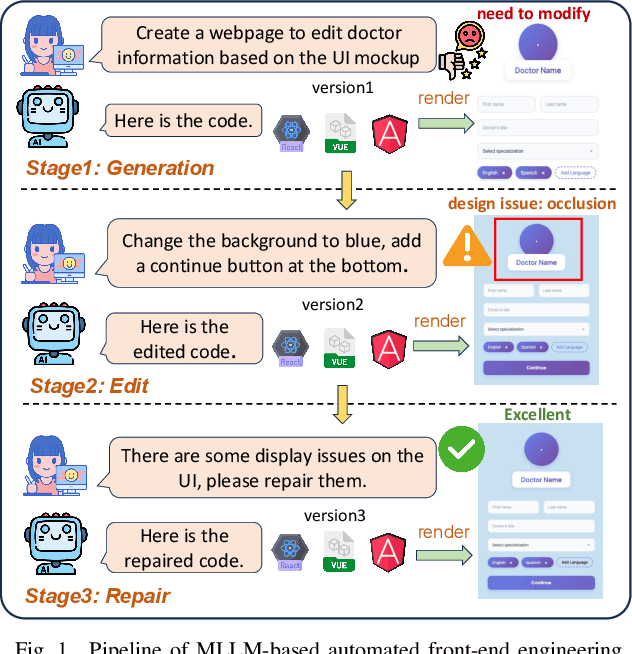
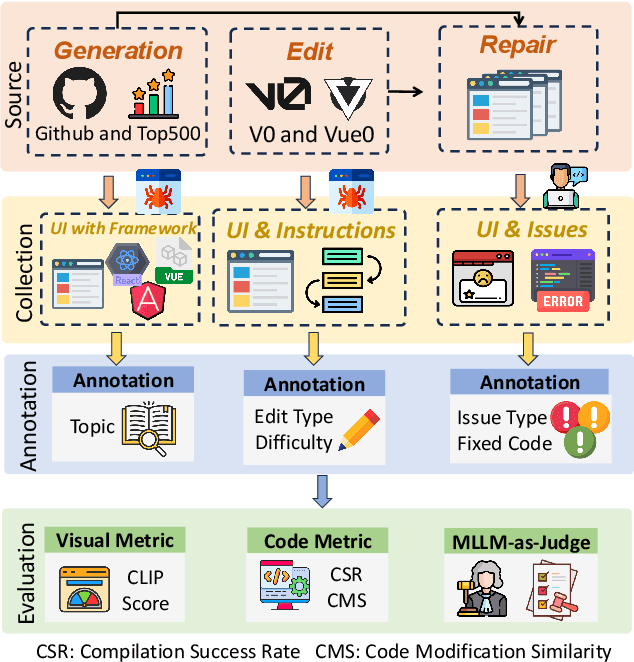

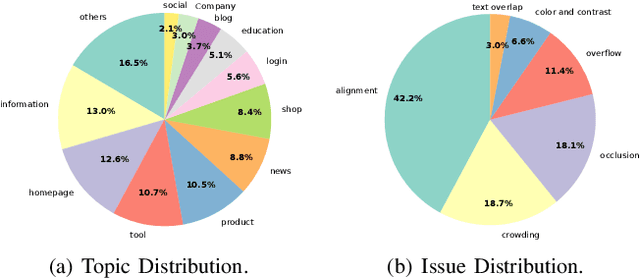
Abstract:Multimodal Large Language Models (MLLMs) have demonstrated remarkable capabilities in automated front-end engineering, e.g., generating UI code from visual designs. However, existing front-end UI code generation benchmarks have the following limitations: (1) While framework-based development becomes predominant in modern front-end programming, current benchmarks fail to incorporate mainstream development frameworks. (2) Existing evaluations focus solely on the UI code generation task, whereas practical UI development involves several iterations, including refining editing, and repairing issues. (3) Current benchmarks employ unidimensional evaluation, lacking investigation into influencing factors like task difficulty, input context variations, and in-depth code-level analysis. To bridge these gaps, we introduce DesignBench, a multi-framework, multi-task evaluation benchmark for assessing MLLMs' capabilities in automated front-end engineering. DesignBench encompasses three widely-used UI frameworks (React, Vue, and Angular) alongside vanilla HTML/CSS, and evaluates on three essential front-end tasks (generation, edit, and repair) in real-world development workflows. DesignBench contains 900 webpage samples spanning over 11 topics, 9 edit types, and 6 issue categories, enabling detailed analysis of MLLM performance across multiple dimensions. Our systematic evaluation reveals critical insights into MLLMs' framework-specific limitations, task-related bottlenecks, and performance variations under different conditions, providing guidance for future research in automated front-end development. Our code and data are available at https://github.com/WebPAI/DesignBench.
Learning a Pessimistic Reward Model in RLHF
May 26, 2025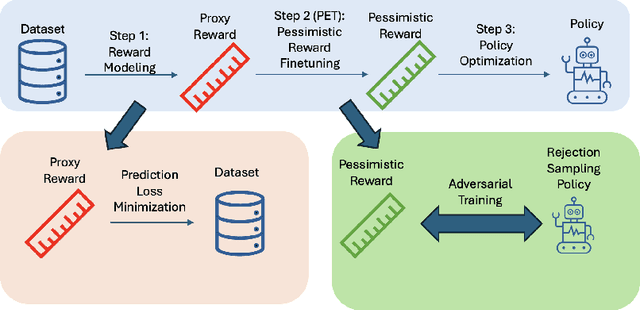


Abstract:This work proposes `PET', a novel pessimistic reward fine-tuning method, to learn a pessimistic reward model robust against reward hacking in offline reinforcement learning from human feedback (RLHF). Traditional reward modeling techniques in RLHF train an imperfect reward model, on which a KL regularization plays a pivotal role in mitigating reward hacking when optimizing a policy. Such an intuition-based method still suffers from reward hacking, and the policies with large KL divergence from the dataset distribution are excluded during learning. In contrast, we show that when optimizing a policy on a pessimistic reward model fine-tuned through PET, reward hacking can be prevented without relying on any regularization. We test our methods on the standard TL;DR summarization dataset. We find that one can learn a high-quality policy on our pessimistic reward without using any regularization. Such a policy has a high KL divergence from the dataset distribution while having high performance in practice. In summary, our work shows the feasibility of learning a pessimistic reward model against reward hacking. The agent can greedily search for the policy with a high pessimistic reward without suffering from reward hacking.
Towards Scalable Foundation Model for Multi-modal and Hyperspectral Geospatial Data
Mar 17, 2025



Abstract:Geospatial raster (imagery) data, such as that collected by satellite-based imaging systems at different times and spectral bands, hold immense potential for enabling a wide range of high-impact applications. This potential stems from the rich information that is spatially and temporally contextualized across multiple channels and sensing modalities. Recent work has adapted existing self-supervised learning approaches for such geospatial data. However, they fall short of scalable model architectures, leading to inflexibility and computational inefficiencies when faced with an increasing number of channels and modalities. To address these limitations, we introduce Low-rank Efficient Spatial-Spectral Vision Transformer (LESS ViT) with three key innovations: i) the LESS Attention Block that approximates high-dimensional spatial-spectral attention through Kronecker's product of the low-dimensional spatial and spectral attention components; ii) the Continuous Positional-Channel Embedding Layer that preserves both spatial and spectral continuity and physical characteristics of each patch; and iii) the Perception Field Mask that exploits local spatial dependencies by constraining attention to neighboring patches. To evaluate the proposed innovations, we construct a benchmark, GFM-Bench, which serves as a comprehensive benchmark for such geospatial raster data. We pretrain LESS ViT using a Hyperspectral Masked Autoencoder framework with integrated positional and channel masking strategies. Experimental results demonstrate that our proposed method surpasses current state-of-the-art multi-modal geospatial foundation models, achieving superior performance with less computation and fewer parameters. The flexibility and extensibility of our framework make it a promising direction for future geospatial data analysis tasks that involve a wide range of modalities and channels.
FetchBot: Object Fetching in Cluttered Shelves via Zero-Shot Sim2Real
Feb 25, 2025

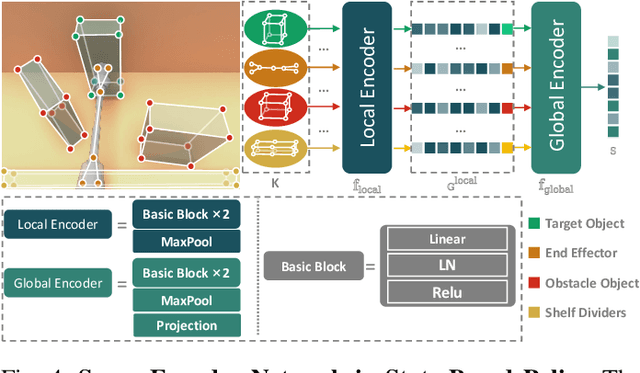

Abstract:Object fetching from cluttered shelves is an important capability for robots to assist humans in real-world scenarios. Achieving this task demands robotic behaviors that prioritize safety by minimizing disturbances to surrounding objects, an essential but highly challenging requirement due to restricted motion space, limited fields of view, and complex object dynamics. In this paper, we introduce FetchBot, a sim-to-real framework designed to enable zero-shot generalizable and safety-aware object fetching from cluttered shelves in real-world settings. To address data scarcity, we propose an efficient voxel-based method for generating diverse simulated cluttered shelf scenes at scale and train a dynamics-aware reinforcement learning (RL) policy to generate object fetching trajectories within these scenes. This RL policy, which leverages oracle information, is subsequently distilled into a vision-based policy for real-world deployment. Considering that sim-to-real discrepancies stem from texture variations mostly while from geometric dimensions rarely, we propose to adopt depth information estimated by full-fledged depth foundation models as the input for the vision-based policy to mitigate sim-to-real gap. To tackle the challenge of limited views, we design a novel architecture for learning multi-view representations, allowing for comprehensive encoding of cluttered shelf scenes. This enables FetchBot to effectively minimize collisions while fetching objects from varying positions and depths, ensuring robust and safety-aware operation. Both simulation and real-robot experiments demonstrate FetchBot's superior generalization ability, particularly in handling a broad range of real-world scenarios, includ
MRWeb: An Exploration of Generating Multi-Page Resource-Aware Web Code from UI Designs
Dec 19, 2024Abstract:Multi-page websites dominate modern web development. However, existing design-to-code methods rely on simplified assumptions, limiting to single-page, self-contained webpages without external resource connection. To address this gap, we introduce the Multi-Page Resource-Aware Webpage (MRWeb) generation task, which transforms UI designs into multi-page, functional web UIs with internal/external navigation, image loading, and backend routing. We propose a novel resource list data structure to track resources, links, and design components. Our study applies existing methods to the MRWeb problem using a newly curated dataset of 500 websites (300 synthetic, 200 real-world). Specifically, we identify the best metric to evaluate the similarity of the web UI, assess the impact of the resource list on MRWeb generation, analyze MLLM limitations, and evaluate the effectiveness of the MRWeb tool in real-world workflows. The results show that resource lists boost navigation functionality from 0% to 66%-80% while facilitating visual similarity. Our proposed metrics and evaluation framework provide new insights into MLLM performance on MRWeb tasks. We release the MRWeb tool, dataset, and evaluation framework to promote further research.
Interaction2Code: How Far Are We From Automatic Interactive Webpage Generation?
Nov 05, 2024



Abstract:Converting webpage design into functional UI code is a critical step for building websites, which can be labor-intensive and time-consuming. To automate this design-to-code transformation process, various automated methods using learning-based networks and multi-modal large language models (MLLMs) have been proposed. However, these studies were merely evaluated on a narrow range of static web pages and ignored dynamic interaction elements, making them less practical for real-world website deployment. To fill in the blank, we present the first systematic investigation of MLLMs in generating interactive webpages. Specifically, we first formulate the Interaction-to-Code task and build the Interaction2Code benchmark that contains 97 unique web pages and 213 distinct interactions, spanning 15 webpage types and 30 interaction categories. We then conduct comprehensive experiments on three state-of-the-art (SOTA) MLLMs using both automatic metrics and human evaluations, thereby summarizing six findings accordingly. Our experimental results highlight the limitations of MLLMs in generating fine-grained interactive features and managing interactions with complex transformations and subtle visual modifications. We further analyze failure cases and their underlying causes, identifying 10 common failure types and assessing their severity. Additionally, our findings reveal three critical influencing factors, i.e., prompts, visual saliency, and textual descriptions, that can enhance the interaction generation performance of MLLMs. Based on these findings, we elicit implications for researchers and developers, providing a foundation for future advancements in this field. Datasets and source code are available at https://github.com/WebPAI/Interaction2Code.
Automatically Generating UI Code from Screenshot: A Divide-and-Conquer-Based Approach
Jun 24, 2024



Abstract:Websites are critical in today's digital world, with over 1.11 billion currently active and approximately 252,000 new sites launched daily. Converting website layout design into functional UI code is a time-consuming yet indispensable step of website development. Manual methods of converting visual designs into functional code present significant challenges, especially for non-experts. To explore automatic design-to-code solutions, we first conduct a motivating study on GPT-4o and identify three types of issues in generating UI code: element omission, element distortion, and element misarrangement. We further reveal that a focus on smaller visual segments can help multimodal large language models (MLLMs) mitigate these failures in the generation process. In this paper, we propose DCGen, a divide-and-conquer-based approach to automate the translation of webpage design to UI code. DCGen starts by dividing screenshots into manageable segments, generating descriptions for each segment, and then reassembling them into complete UI code for the entire screenshot. We conduct extensive testing with a dataset comprised of real-world websites and various MLLMs and demonstrate that DCGen achieves up to a 14% improvement in visual similarity over competing methods. To the best of our knowledge, DCGen is the first segment-aware prompt-based approach for generating UI code directly from screenshots.
Deep Learning for Detecting and Early Predicting Chronic Obstructive Pulmonary Disease from Spirogram Time Series: A UK Biobank Study
May 06, 2024



Abstract:Chronic Obstructive Pulmonary Disease (COPD) is a chronic inflammatory lung condition that causes airflow obstruction. The existing methods can only detect patients who already have COPD based on obvious features shown in the spirogram (In this article, the spirogram specifically involves measuring Volume-Flow curve time series). Early prediction of COPD risk is vital for monitoring COPD disease progression, slowing it down, or even preventing its onset. However, these methods fail to early predict an individual's probability of COPD in the future based on subtle features in the spirogram. To address this gap, for the first time, we propose DeepSpiro, a method based on deep learning for early prediction of future COPD risk. DeepSpiro consists of four parts. First, we construct Volume-Flow curves guided by Time-Volume instability smoothing (SpiroSmoother) to enhance the stability of the original Volume-Flow curves precisely. Second, we extract critical features from the evolution of varied-length key patches (SpiroEncoder) to capture the key temporal evolution from original high-dimensional dynamic sequences to a unified low-dimensional temporal representation. Third, we explain the model based on temporal attention and heterogeneous feature fusion (SpiroExplainer), which integrates information from heterogeneous data such as spirogram and demographic information. Fourth, we predict the risk of COPD based on the evolution of key patch concavity (SpiroPredictor), enabling accurate prediction of the risk of disease in high-risk patients who are not yet diagnosed, for up to 1, 2, 3, 4, 5 years, and beyond. We conduct experiments on the UK Biobank dataset. Results show that DeepSpiro achieves an AUC value of 0.8328 in the task of detecting COPD. In early prediction tasks, high-risk and low-risk groups show significant differences in the future, with a p-value of <0.001.
SCANet: Correcting LEGO Assembly Errors with Self-Correct Assembly Network
Mar 27, 2024Abstract:Autonomous assembly in robotics and 3D vision presents significant challenges, particularly in ensuring assembly correctness. Presently, predominant methods such as MEPNet focus on assembling components based on manually provided images. However, these approaches often fall short in achieving satisfactory results for tasks requiring long-term planning. Concurrently, we observe that integrating a self-correction module can partially alleviate such issues. Motivated by this concern, we introduce the single-step assembly error correction task, which involves identifying and rectifying misassembled components. To support research in this area, we present the LEGO Error Correction Assembly Dataset (LEGO-ECA), comprising manual images for assembly steps and instances of assembly failures. Additionally, we propose the Self-Correct Assembly Network (SCANet), a novel method to address this task. SCANet treats assembled components as queries, determining their correctness in manual images and providing corrections when necessary. Finally, we utilize SCANet to correct the assembly results of MEPNet. Experimental results demonstrate that SCANet can identify and correct MEPNet's misassembled results, significantly improving the correctness of assembly. Our code and dataset are available at https://github.com/Yaser-wyx/SCANet.
 Add to Chrome
Add to Chrome Add to Firefox
Add to Firefox Add to Edge
Add to Edge